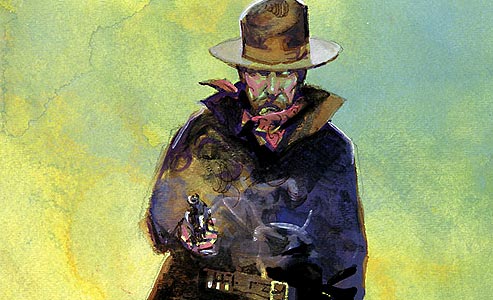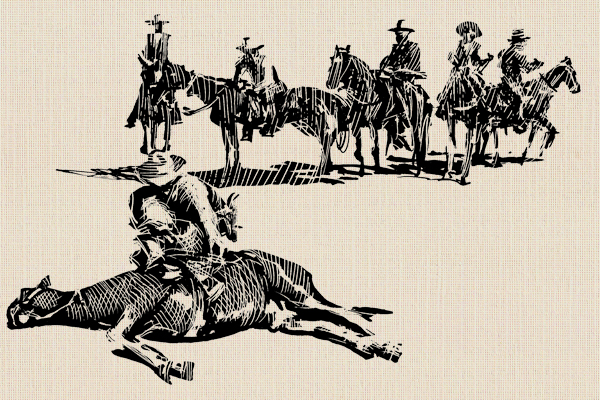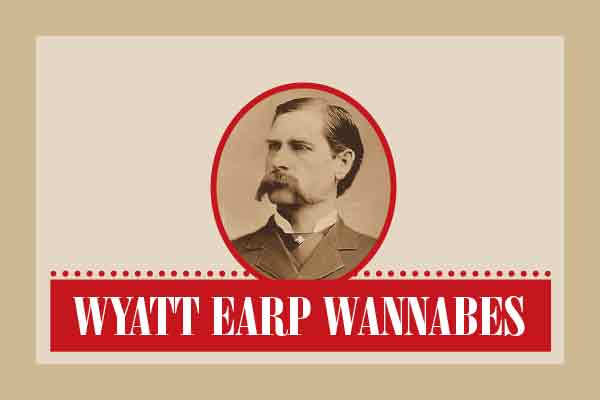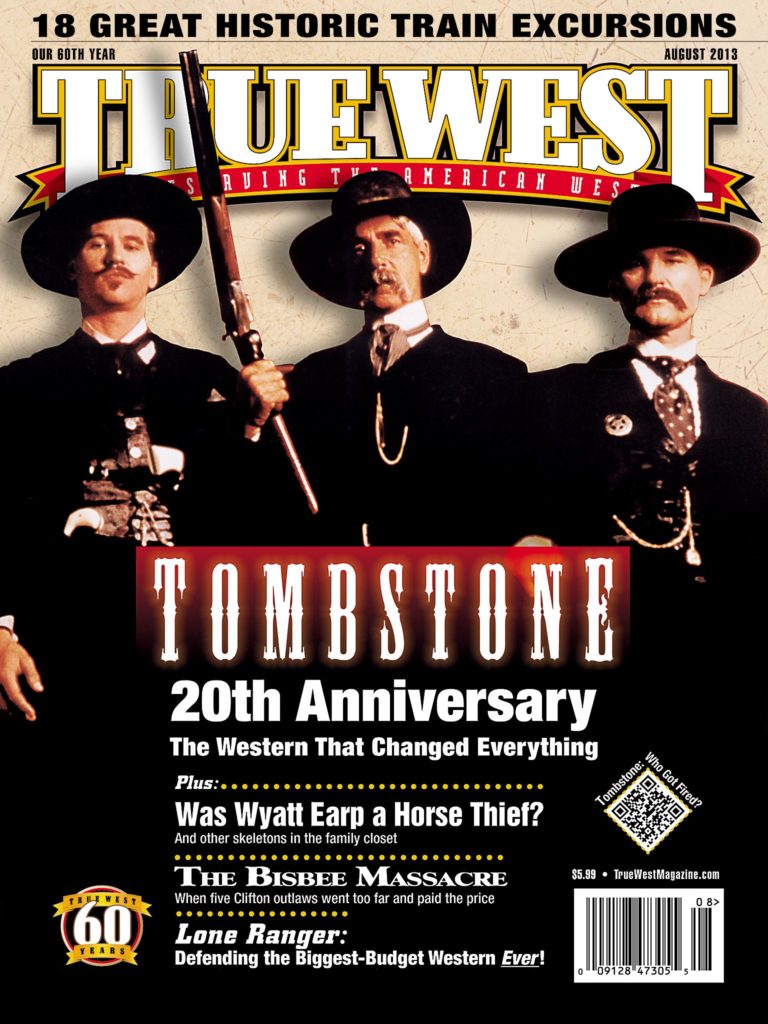 Wyatt Earp’s 1871 arrest for horse theft in the Indian Territory, which first came to light in Ed Bartholomew’s book, Wyatt Earp, 1848 to 1880: The Untold Story, has long troubled some of Earp’s defenders.
Wyatt Earp’s 1871 arrest for horse theft in the Indian Territory, which first came to light in Ed Bartholomew’s book, Wyatt Earp, 1848 to 1880: The Untold Story, has long troubled some of Earp’s defenders.
At the time of the book’s publication in 1963, the image of Earp as a stalwart Western lawman was at its height. Frank Waters had taken a stab at bringing the reputation down a few notches, with his 1960 book, The Earp Brothers of Tombstone, but most people still saw Earp as a hero. The horse theft charge was such a direct challenge to that impression that some defenders of Earp’s reputation have denied that the man who became a police officer in Kansas and Arizona could have been capable of such a crime. One defender, Earl Chafin, went so far as to suggest that the arrestee was “another Wyatt Earp, a lawless ex-Confederate soldier from Tennessee.”
Geography suggests that the man arrested for horse theft was, as Chafin put it, “our” Wyatt. Earp was in Lamar, Missouri, in late 1870, a few months before and less than 100 miles away from Fort Gibson, where the theft allegedly took place. He left Lamar under a cloud, accused of having absconded with public funds. While it seems likely that “our” Earp was arrested in Indian Territory in 1871, an unanswered question remains: did Earp actually commit horse theft? Police corruption and false arrests in Indian Territory in 1871 suggest he may have been in the wrong place at the wrong time.
Brutal and Corrupt
Of all the dangerous places in which Earp found himself in the course of his turbulent life—including Dodge City and Tombstone—the Indian Territory in 1871 was in many respects the most brutal and corrupt. The resident Cherokees, whom the government had forcibly removed to the Indian Territory from Georgia in the 1830s, were divided into bitter factions that frequently exploded into violence. Numerous outlaws found refuge in the sparsely populated Indian Territory, a vast region under the tenuous legal authority of the Western District of Arkansas court. Many of the Western District’s notoriously corrupt deputy U.S. marshals had been schooled in the violence of the Civil War—some had reportedly been members of William Quantrill’s irregular force. Precisely because of this reputation for violence, Charles Portis set his 1968 novel True Grit in the Western District.
Corruption in the Western District was widespread. In 1866, the principal chief of the Choctaws, Peter Pitchlynn, who occupied a reservation in the southeastern corner of Indian Territory, complained that the deputy U.S. marshals for the Western District “annoyed and harassed” them by “going about our country with an armed force and arresting numbers of our citizens for offenses alleged to have been committed….” The arrests, the Choctaw chief argued, “are without any just cause, the main inducement with the assistant marshals being to make fees thereby….”
By 1874, the abuses in the Western District prompted a committee of the U.S. House of Representatives to hold hearings. Their findings confirmed the charges of the Choctaws: false arrests and fraudulent accounts were the norm.
The deputy U.S. marshals ought to have been kept busy policing real crime in Indian Territory. In its spring 1869 session, the Western District court tried one Chickasaw and three Cherokee men for three separate murders. In September, two Choctaws—one a veteran of the Confederate Army—murdered a black man and a Choctaw man in order to steal the goods they were hauling to a store in Indian Territory.
Across the border in Arkansas, disputes were also deadly. In May 1869, John Read, who was in Van Buren to serve as a juror in the district court, shot and killed William Bledsoe rather than surrender to him the horse that Bledsoe had won from him in a wager. In August of the same year, Monroe Srum shot Harris Thomas to prevent Thomas from courting Srum’s sister. As in other parts of the Reconstruction-era South, white violence against blacks in western Arkansas was rarely punished: three white men who killed a black man in 1869 were acquitted because the only testimony against them came from black witnesses. White supremacist societies operated with such impunity that the Van Buren baseball team called itself the Ku Klux Klub.
Altogether, the Indian Territory was not a place for anyone looking to stay out of trouble. As such, Earp, who arrived in the territory shortly after leaving Lamar, found himself in trouble in short time.
Wyatt, the Horse Thief
On April 1, 1871, Jacob Owens,* a deputy U.S. marshal of the Western District, filed his bill of information that accused Earp and two other men of stealing two horses.
“…Wyatt S. Earp, Ed Kennedy, John Shown,” Owens wrote, “on the 28th day of March AD 1871 in the Indian Country in said District did feloniously willfully steal, take and carry away two horses each of the value of one hundred dollars, the property goods and chattels of one William Keys.”
Anna Shown contended that Earp and Kennedy had duped her husband into stealing the horses. She told Owens: “They got my husband drunk near Ft. Gibson, I.T., about the 28th of March 1871. They went and got Mr. Jim Keys horses, and put my husband on one and he lead [sic] the other, and told him to ride fifty miles toward Kansas…” where they would meet him.
Her husband John had ridden with the stolen horses to the thieves’ appointed meeting place north of Fort Gibson; Anna accompanied Earp and Kennedy there in a hack. Once reunited, the four hitched the stolen horses to the hack and continued their flight toward Kansas, driving the horses at night and resting by day to avoid detection. Keys, however, followed their trail and overtook them after three days.
“Earp and Kennedy told Keys that my husband stole the horses. They also said that if Shown [my husband] turned states evidence then they would kill him,” Anna claimed.
Six days after Keys overtook and apprehended the thieves, Owens and other posse members took Earp, Kennedy and John into custody. Owens returned with the prisoners to the Western District courthouse in Van Buren, a building set on a square overrun with unfenced swine (the local newspaper waggishly referred to the courthouse square as “our public pasture”). On April 14, at Earp, Kennedy and Shown’s arraignment, James Churchill, U.S. commissioner for the Western District, set bail at $500 each. Unable to make bail, Earp found himself confined in the district jail in Van Buren.
Doomed to the “Hole in the Wall?”
Horse theft was a felony and, together with counterfeiting, was one of the most common felonies on the 19th-century frontier. But contrary to popular belief, it was not a capital crime in the American West in 1871. The last time a court in the U.S. had ordered anyone hanged for stealing horses was in California in 1851. If Earp had been convicted of horse theft, he likely would have been sentenced to five years in the federal penitentiary in Little Rock. That was the sentence handed down to three horse thieves in the Western District court in December 1869. A horse thief on the “middle border” where Missouri, Kansas, Arkansas and the Indian Territory converged had more to fear from vigilantes than from the authorities. In the fall of 1870, in Butler County, Kansas—less than 100 miles from Fort Gibson—a vigilance committee of nearly 800 men lynched eight suspected horse thieves.
While the authorities did not hang horse thieves, a sentence of five years in prison was a sobering prospect for 23-year-old Earp. If convicted, Earp would have spent some of that time in the Western District courthouse jail before being transferred to Little Rock to finish his term. Though Earp may not have known it, between his arraignment and his scheduled trial, the Western District of Arkansas court was scheduled to move from Van Buren a few miles west, across the Arkansas River, to the abandoned Army post of Fort Smith. A Western District marshal had transformed two rooms in the basement of the new Fort Smith courthouse into a jail. A Van Buren newspaper reporter described the Fort Smith jail shortly after its opening as a “Hole in the Wall” that was “gloomy and dark and rank.”
When Anna Dawes visited Fort Smith with her father, Sen. Henry Dawes, in 1885, she described the jail as consisting of two dark, low rooms, with as many as 50 men per room. Light and ventilation entered each room through windows that opened into the areas beneath the ground-floor verandas. A single chamber pot—placed in the unused fireplace in the hope that the stench would be carried up through the chimney—served all of the inmates of a room. Prisoners slept on wooden cots and were given few opportunities to wash. Anna described the jail as “dirty beyond description” and a “piece of mediaeval barbarity.”
Bold Daylight Escape
Earp did not stay in Arkansas long enough to experience the basement dungeon in Fort Smith. He and five other men would make a bold daylight escape on May 3, roughly two weeks after his arraignment and only days before the court moved to Fort Smith.
Earp found himself among 10 men confined to a cell in the upper story of the soon-to-be-defunct Van Buren jailhouse. His cellmates included John Shown, the man he had allegedly duped into horse theft; two accused murderers who faced hanging; and two brothers, Henry and Jerry Perry, charged with counterfeiting and the attempted murder of Benjamin Shoemaker, a Western District deputy marshal.
Earp, Shown, the Perry brothers and the two accused murderers pried off the rafters in one corner of the cell, hoisted themselves into the low attic and crawled across the rafters to a small, grated window that provided ventilation. They enlarged the window opening by removing some stones from the building’s exterior wall. Tying blankets from their cell into a rope, they lowered themselves 20 feet to the ground. After they crawled under the fence surrounding the jailhouse, they were free.
Trumped Up Charge?
On May 8, the court issued a writ ordering Western District Marshal William Britton to force Earp and Shown to appear for trial in November. A week later, Kennedy, Shown and Earp (the latter two in absentia) were indicted for horse theft in Fort Smith.
Kennedy was tried on June 5, and he ended up being acquitted of the crime. The acquittal was not entirely unusual: the most complete study of prosecutions on the frontier indicates that only about half of all indictments led to convictions. In the Western District, where the authorities arrested numerous people on trumped-up charges, the conviction rate was even lower: in its November 1871 term, 28 criminal cases (including Earp’s case) were carried over from the May term and added to 238 new indictments. Of those 266, prosecutors secured only 51 convictions; the court saw 45 acquittals and 77 continuances. To be fair, the low conviction rate does not necessarily point to a defendant’s innocence. Yet the low conviction rate in the Western District—far lower than in most frontier courts—was in all likelihood a result of the large number of cases that had started as false arrests.
Was Earp one of those arrested on trumped-up charges? The historical record offers more questions than answers. The deputy marshals of the Western District notoriously made arrests on specious charges simply to collect fees for their services. As one former deputy marshal testified to Congress in 1874, “We would go out and gobble up everybody that we could get hold of. Marshal Britton told us to arrest any person that there was any charge against and bring them to Fort Smith; that we could get warrants when we got here.”
To exploit the system to the fullest, Britton also exaggerated the number of men in a posse and the number of miles they traveled so he could claim greater expenses. In return, Britton kept a third of the inflated expenses that were intended to be paid out to
his subordinates.
Earp may have been gobbled up by Britton’s corrupt system. Owens, the deputy marshal who signed the bill of complaint against Earp, was one of the deputies who lined his pockets by arresting unoffending Indians and the occasional white vagrant and conveying them to the court in Arkansas. In 1874, Deputy U.S. Marshal Shoemaker testified that Owens was one of the “confidential men” who routinely committed fraud by exaggerating the number of men in posses. Moreover, Shoemaker reported, Owens had pressured him into giving false testimony when a federal investigator came to Fort Smith in 1873 to look into the fraud charges.
Owens was not called to testify in that Congressional inquiry. This was not, however, because he was above suspicion, but because he, accompanied by another of the Western District’s “confidential men,” had been killed in a bloody shoot-out in the Indian Territory in 1872, only a year after Earp’s escape.
Owens had died while trying to arrest a Cherokee man for attempted murder, only to find himself in the middle of a violent Cherokee feud between the Cherokee members of his posse and the accused man’s supporters. Eight men were wounded and 11 killed in the shoot-out (two died the next day).
Owens—the only man who could say with certainty whether Earp was falsely accused in 1871—was shot through the abdomen and lingered for a day before dying.
Andrew C. Isenberg covers this history in his book, Wyatt Earp: A Vigilante Life, published by Hill and Wang in June 2013. A professor of history at Temple University, he is a historian of the American environment, the American West and the encounter between natives and settlers.






